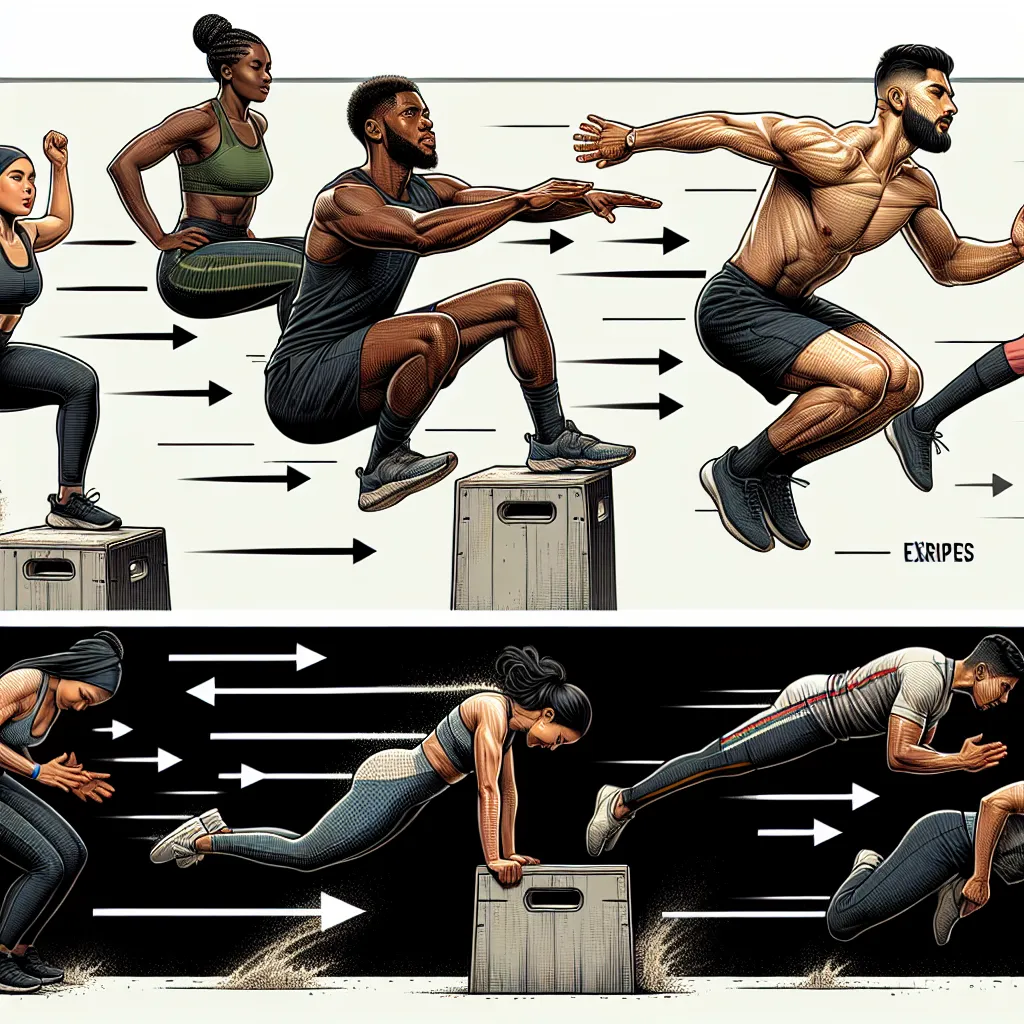Plyometric exercises, a cornerstone of modern athletic training, are increasingly appearing in IELTS exams. Let’s dive into this dynamic vocabulary to enhance your language skills and boost your IELTS performance.
Definition and Pronunciation
Plyometric exercises (noun)
/plaɪəˈmetrɪk ˈeksəsaɪzɪz/
Definition: Training techniques that involve rapid, powerful movements to increase muscle strength and explosiveness.

Context and Usage
Examples in Context
-
Plyometric exercises are essential for athletes looking to improve their vertical jump.
Analysis: This sentence highlights the specific benefit of plyometrics in sports performance. -
The coach incorporated plyometric exercises into our training regimen to enhance our explosive power.
Analysis: Here, we see the integration of plyometrics into a broader training program. -
Studies show that plyometric exercises can significantly boost running economy and agility.
Analysis: This example demonstrates the scientific backing for plyometric training, linking it to running economy and agility. -
Be cautious when starting plyometric exercises; they can be intense and require proper form to avoid injury.
Analysis: This sentence emphasizes the importance of safety and proper technique in plyometric training. -
Advanced plyometric exercises like depth jumps should only be attempted by experienced athletes.
Analysis: Here, we introduce a specific type of plyometric exercise, indicating a progression in difficulty levels.
Common Contexts
Plyometric exercises are frequently discussed in sports science, fitness training, and physical therapy contexts. They’re often mentioned in relation to athletic performance enhancement, injury prevention, and rehabilitation programs.
IELTS Frequency
In IELTS exams, “plyometric exercises” may appear in:
- Reading passages about sports science or fitness trends (medium frequency)
- Listening sections featuring discussions on athletic training (low to medium frequency)
- Writing Task 2 essays on health and fitness topics (low frequency)
- Speaking Part 3 discussions about exercise and sports (low frequency)
Vocabulary Analysis
Word Structure
- Plyo- (prefix): Meaning “more” or “increased”
- -metric (suffix): Relating to measurement
- Exercise (root): Physical activity for health or training
Synonyms and Antonyms
Synonyms:
- Jump training /dʒʌmp ˈtreɪnɪŋ/ (noun): Exercises involving various jumping techniques.
- Explosive training /ɪkˈspləʊsɪv ˈtreɪnɪŋ/ (noun): Exercises focusing on rapid, powerful movements.
- Ballistic exercises /bəˈlɪstɪk ˈeksəsaɪzɪz/ (noun): Quick, explosive movements often involving throwing or jumping.
Antonyms:
- Static exercises /ˈstætɪk ˈeksəsaɪzɪz/ (noun): Exercises performed without movement, like planks or holds.
- Isometric training /ˌaɪsəʊˈmetrɪk ˈtreɪnɪŋ/ (noun): Exercises that contract muscles without changing their length.
- Endurance training /ɪnˈdjʊərəns ˈtreɪnɪŋ/ (noun): Exercises focused on stamina rather than explosive power.
Memorization Techniques
Mind Map
Create a mind map with “Plyometric Exercises” at the center, branching out to:
- Types (box jumps, burpees, clap push-ups)
- Benefits (improved power, agility, speed)
- Related concepts (anaerobic power, muscle elasticity)
- Safety considerations (proper form, gradual progression)
Storytelling Technique
Imagine a sprinter named Plyo (short for Plyometric). Plyo loves to jump, bounce, and explode into action. Every day, Plyo performs magical exercises that make him faster and stronger. These exercises are like secret weapons, helping Plyo leap higher and run quicker than ever before. Remember, Plyo’s exercises are powerful and need to be done carefully to avoid getting hurt.
Practice Exercises
-
Gap Fill:
Complete the sentence: “The basketball team incorporated into their training to improve their vertical leap.” -
Sentence Formation:
Create a sentence using “plyometric exercises” and at least one of its synonyms. -
IELTS Writing Task 2 Practice:
Some people believe that high-intensity exercises like plyometrics are essential for fitness, while others prefer low-impact activities. Discuss both views and give your opinion. -
IELTS Speaking Part 3 Practice:
Question: How do you think modern training methods like plyometric exercises have changed sports performance? -
Contextual Usage:
Write a paragraph about the benefits and risks of plyometric exercises in a rehabilitation program.
Conclusion
Mastering the term “plyometric exercises” and its related vocabulary can significantly enhance your performance in the IELTS exam, particularly in sections dealing with sports and fitness. Remember to practice using this term in various contexts, and don’t hesitate to incorporate it into your writing and speaking exercises.
We encourage you to share your experiences with learning and using this term in the comments below. Have you encountered “plyometric exercises” in your IELTS preparation or in real-life contexts? How has understanding this concept improved your English language skills? Your insights could be valuable for fellow learners!